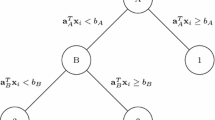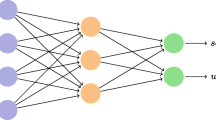Abstract
The hybrid search algorithm for constraint satisfaction problems described here first uses local search to detect crucial substructures and then applies that knowledge to solve the problem. This paper shows the difficulties encountered by traditional and state-of-the-art learning heuristics when these substructures are overlooked. It introduces a new algorithm, Foretell, to detect dense and tight substructures called clusters with local search. It also develops two ways to use clusters during global search: one supports variable-ordering heuristics and the other makes inferences adapted to them. Together they improve performance on both benchmark and real-world problems.
Similar content being viewed by others
References
Bessière, C., Chmeiss, A., Saîs, L.: Neighborhood-based variable ordering heuristics for the constraint satisfaction problem. In: Proceedings of Principles and Practice of Constraint Programming (CP2001), Paphos, Cyprus, pp. 565–569 (2001)
Boussemart, F., et al.: Boosting systematic search by weighting constraints. In: Proceedings of the Sixteenth European Conference on Artificial Intelligence (ECAI-2004), Valencia, Spain, pp. 146–150 (2004)
Cabon, R., et al.: Radio link frequency assignment. Constraints 4, 79–89 (1999)
Cambazard, H., Jussien, N.: Identifying and exploiting problem structures using explanation-based constraint programming. Constraints 11, 295–313 (2006)
Cohen, D.A., Green, M.J.: Typed guarded decompositions for constraint satisfaction. In: Proceedings of Principles and Practice of Constraint Programming (CP2006), Nantes, France, pp. 122–136 (2006)
Dechter, R.: Enhancement schemes for constraint processing: backjumping, learning and cutset decomposition. Artif. Intell. 41, 273–312 (1990)
Dechter, R., Pearl, J.: The cycle-cutset method for improving search performance in AI applications. In: Proceedings of Third IEEE on AI Applications, Orlando, Florida, pp. 224–230 (1987)
Dechter, R., Pearl, J.: Tree clustering for constraint networks. Artif. Intell. 38, 353–366 (1989)
Dilkina, B., Gomes, C.P., Sabharwal, A.: Tradeoffs in the complexity of backdoor detection. In: Proceedings of Principles and Practice of Constraint Programming (CP2007), pp. 256–270. Providence, Rhode Island (2007)
Epstein, S.L., Freuder, E.C., Wallace, R.J.: Learning to support constraint programmers. Comput. Intell. 21(4), 337–371 (2005)
Epstein, S.L., Wallace, R.J.: Finding crucial subproblems to focus global search. In: Proceedings of IEEE International Conference on Tools with Artificial Intelligence (ICTAI-2006), Washington, D.C., pp. 151–159 (2006)
Freuder, E.C.: Exploiting structure in constraint satisfaction problems. In: Proceedings of Constraint Programming: NATO Advanced Science Institute Series, Parnu, Estonia, pp. 54–79 (1994)
Freuder, E.C.: A sufficient condition for backtrack-free search. J. ACM 29(1), 24–32 (1982)
Gent, I., et al.: An empirical study of dynamic variable ordering heuristics for the constraint satisfaction problem. In: Proceedings of Principles and Practice of Constraint Programming (CP1999), pp. 179–193. Cambridge, MA, USA (1996)
Gompert, J., Choueiry, B.Y.: A decomposition techniques for CSPs using maximal independent sets and its integration with local search. In: Proceedings of FLAIRS-2005, Clearwater Beach, FL, pp. 167–174 (2005)
Gyssens, M., Jeavons, P.G., Cohen, D.A.: Decomposing constraint satisfaction problems using database techniques. Artif. Intell. 66(1), 57–89 (1994)
Hansen, P., Mladenovic, N.: Variable neighborhood search. In: Glover, F.W., Kochenberger, G.A. (eds.) Handbook of Metaheuristics, pp. 145–184. Springer, Berlin (2003)
Hansen, P., Mladenovic, N., Urosevic, D.: Variable neighborhood search for the maximum clique. Discrete Appl. Math. 145, 117–125 (2004)
Haralick, R.M., Elliot, G.L.: Increasing tree-search efficiency for constraint satisfaction problems. Artif. Intell. 14, 263–313 (1980)
Hemery, F., et al.: Extracting MUCs from constraint networks. In: Proceedings of 17th European Conference on Artificial Intelligence (ECAI-2006), Riva del Garda, pp. 113–117 (2006)
Junker, U.: QuickXplain: preferred explanations and relaxations for over-constrained problems. In: Proceedings of AAAI-2004, San Jose, California, pp. 167–172 (2004)
Kroc, L., Sabharwal, A., Selman, B.: Counting solution clusters in graph coloring problems using belief propagation. In: Proceedings of Twenty-Second Annual Conference on Neural Information Processing Systems (NIPS-2008), Vancouver, Canada, pp. 873–880 (2008)
Lecoutre, C.: Benchmarks—XML representation of CSP instances. Available online at http://www.cril.univ-artois.fr/~lecoutre/research/benchmarks/benchmarks.html
Li, X., Epstein, S.L.: Visualization for structured constraint satisfaction problems. In: Proceedings of the AAAI workshop on visual representation and reasoning, Atlanta, GA (2010)
Luby, M., Sinclair, A., Zuckerman, D.: Optimal speedup of Las Vegas algorithms. Inf. Process. Lett. 47, 173–180 (1993)
Mackworth, A.K., Freuder, E.C.: The complexity of constraint satisfaction revisited. Artif. Intell. 59, 57–62 (1993)
Mackworth, A.K., Freuder, E.C.: The complexity of some polynomial network consistency algorithms for constraint satisfaction problems. Artif. Intell. 25(1), 65–74 (1985)
Markstrom, K.: Locality and hard SAT-instances. JSAT 2, 221–227 (2006)
Mézard, M., Parisi, G., Zecchina, R.: Analytic and algorithmic solution of random satisfiability problems. Science 297(5582), 812–815 (2002)
Minton, S., et al.: Solving large scale constraint satisfaction and scheduling problems using a heuristic repair method. In: Proceedings of AAAI-1990, Boston, MA, pp. 17–24 (1990)
Razgon, I., O’Sullivan, B.: Efficient recognition of acyclic clustered constraint satisfaction problems. In: Proceedings of 11th Annual ERCIM International Workshop on Constraint Solving and Constraint Logic Programming at CSCLP 2006 (2006)
Refalo, P.: Impact-based search strategies for constraint programming. In: Proceedings of Principles and Practice of Constraint Programming (CP 2004), Toronto, Canada, pp. 556–571 (2004)
Ruan, Y., Horvitz, E., Kautz, H.: The backdoor key: a path to understanding problem hardness. In: Proceedings of AAAI-2004, San Jose, CA, pp. 124–130 (2004)
Sabin, D., Freuder, E.C.: Understanding and improving the MAC algorithm. In: Proceedings of Principles and Practice of Constraint Programming (CP1997), Linz, Austria, pp. 167–181 (1997)
Sacerdoti, E.D.: Planning in a hierarchy of abstraction spaces. Artif. Intel. 5(2), 115–135 (1974)
Samer, M., Szeider, S.: Constraint satisfaction with bounded treewidth revisited. In: Proceedings of Principles and Practice of Constraint Programming (CP2006), Nantes, pp. 499–513 (2006)
Smith, B.M.: The Brélaz heuristic and optimal static orderings. In: Proceedings of Principles and Practice of Constraint Programming (CP1999), Alexandria, Virginia, pp. 405–418 (1999)
van Dongen, S.: Graph clustering by flow simulation. Ph.D. thesis, University of Utrecht (2000)
Weigel, R., Faltings, B.: Compiling constraint satisfaction problems. Artif. Intell. 115, 257–287 (1999)
Zheng, Y., Choueiry, B.Y.: Applying decomposition methods to crossword puzzle problems. In: Proceedings of Principles and Practice of Constraint Programming (CP2005), Sitges, Spain, pp. 874 (2005)
Author information
Authors and Affiliations
Corresponding author
Rights and permissions
About this article
Cite this article
Li, X., Epstein, S.L. Learning cluster-based structure to solve constraint satisfaction problems. Ann Math Artif Intell 60, 91–117 (2010). https://doi.org/10.1007/s10472-010-9212-z
Published:
Issue Date:
DOI: https://doi.org/10.1007/s10472-010-9212-z




